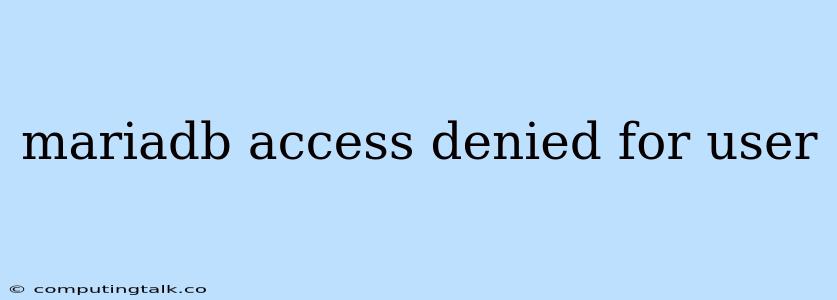MariaDB Access Denied for User: Troubleshooting and Solutions
Encountering the "MariaDB Access Denied for User" error can be frustrating, but it's a common issue that can be resolved with a systematic approach. This error arises when a user account lacks the necessary privileges to access the database, or when there is a mismatch in the authentication credentials provided. This article will guide you through understanding the error, diagnosing its cause, and implementing effective solutions.
Understanding the Error
The MariaDB Access Denied for User error message typically appears during database connection attempts. It indicates that the user attempting to connect lacks the proper permissions to access the database or specific tables. There are several potential culprits behind this error, including:
- Incorrect Username or Password: Double-check the username and password used for the connection. Even a small typo can lead to access denial.
- Missing or Incorrect User Privileges: The user might be missing the required permissions to access the database. For example, the user might not have the
SELECTprivilege for a specific table. - Incorrect Hostname: The hostname specified in the connection string might not match the hostname configured for the user's account in MariaDB.
- Database Lockdown: The database administrator might have restricted access for security purposes.
- Authentication Errors: There might be a problem with the authentication method employed (e.g., password hashing, user authentication configuration).
Troubleshooting Steps
To effectively tackle the MariaDB Access Denied for User error, follow these steps:
-
Verify Username and Password:
- Confirm that you are using the correct username and password for the database connection.
- Ensure there are no typos in the credentials entered.
- Consider resetting the password for the user if there's a possibility of it being forgotten.
-
Check User Privileges:
-
Log in as the root user to the MariaDB shell (e.g.,
mysql -u root -p). -
Use the
SHOW GRANTS FOR 'username'; command to list all the privileges assigned to the user. -
If the user lacks the required permissions, use the
GRANTcommand to provide the necessary privileges. For example:GRANT SELECT, INSERT, UPDATE, DELETE ON database_name.* TO 'username'@'hostname'; -
Replace
database_name,username, andhostnamewith the appropriate values.
-
-
Examine Hostname Configuration:
- Check the
mysql.usertable within the MariaDB database to verify the hostnames associated with the user account. - Ensure that the hostname used for connection matches the hostname configured in the
mysql.usertable. - If necessary, modify the hostname in the
mysql.usertable or in the connection string.
- Check the
-
Check for Database Lockdown:
- Examine the
mysql.usertable to see if any user accounts have been locked or disabled. - If the account is locked, you might need to unlock it using the
UNLOCK USER 'username'@'hostname';command.
- Examine the
-
Verify Authentication Method:
- Review the MariaDB configuration file (usually
my.cnf) to ensure that the authentication method (e.g.,mysql_native_password,caching_sha2_password) matches the authentication settings for the user account. - If there is a mismatch, adjust the settings accordingly.
- Review the MariaDB configuration file (usually
Example Scenario
Let's assume you have a user named 'app_user' who needs to access a database called 'my_database'. You encounter the MariaDB Access Denied for User error when trying to connect with this user.
-
Check User Privileges:
mysql> SHOW GRANTS FOR 'app_user'@'localhost'; +-------------------------------------------------------+ | Grants for app_user@localhost | +-------------------------------------------------------+ | GRANT USAGE ON *.* TO 'app_user'@'localhost' | +-------------------------------------------------------+In this case, the user only has
USAGEprivileges, which means they can't access any tables. -
Grant Privileges:
mysql> GRANT SELECT, INSERT, UPDATE, DELETE ON my_database.* TO 'app_user'@'localhost';Now, the user has the necessary privileges to perform CRUD operations on the database.
Common Solutions
- Ensure Correct Credentials: Always double-check the username and password you use for the connection.
- Grant Necessary Privileges: Use the
GRANTcommand to provide the user with the required permissions. - Verify Hostname Configuration: Ensure the hostname matches between the database configuration and the connection string.
- Check for Database Lockdown: Unlock any locked user accounts if necessary.
Conclusion
The MariaDB Access Denied for User error is a common obstacle when working with MariaDB. By following the troubleshooting steps and implementing the solutions outlined in this article, you can identify the root cause of the error and restore access to your database. Remember to always prioritize security and grant only the necessary privileges to users, ensuring a stable and secure MariaDB environment.
